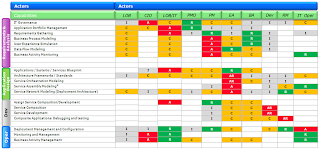It is important to do this in the context of the Services Life Cycle and did publish a short presentation on this topic a couple of months back. This presentations is a summary of the SOA Practitioners Guide Part 3: Introduction to Services Life Cycle with the addition of the IT Engagement Model slide (14) shown below.

This is the RACI (Responsible, Accountable, Consulted and Informed) slide listing all the roles and responsiblities of various actors across the services lifecycle. This is pretty generic in nature and could also be applied to non-SOA lifecycles too.
You comments are always welcome and do feel free to drop me line.
- Yogish Pai

3 comments:
The information is brilliant ..I found many more useful things from your blog on IT Thanks for this great informative points.
What a good blog you have here. Please update it more often. This topics is my interest. Thank you. . .
java software outsourcing company ukraine
Good article, thank you) I want to point out for myself that it's often better to outsource a lot of the work. This can save a lot of money, because often, especially in IT, companies do not need employees on a permanent basis, they need them for individual projects. Recruiting services can also be outsourced. Few people have thought about it, but hr outsourcing pricing can vary greatly from country to country, which can help save a significant amount of money.
Post a Comment